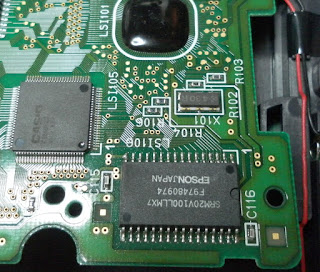Casio CFX-9970G (aka CFX-9990GT or Graph 80 in France)
This is a beast of a machine, very powerful features at their time, and the hardware implementation is uncommon having four stacked pcb boards.
The top pcb board module is a 8Mbits PROM firmware module inserted into a slot in the processor mainboard like we see in professional laptop computers.
The processor board interconnects with the other two boards (keyboard and display) using soldered flat cables.
The flat cable connectors are adequate to resist several maintenance operations without breaking. They don't do it like this anymore.
Selecting System from the Menu, it tells me that it has just 63443 Bytes free after a clear memory operation.
Running the the self test by pressing F6 + a b/c + AC/ON.
This calculator shows this model code: ZX936
This CFX-9970GT shows 4MBit Version 1 + 8MBit Version 2.
I guess one of these ROM chips holds the CAS code.
This CFX-9970GT shows 128KB in the RAM test.
Same forensics result as found on other cfx-9850GB Plus series, so the processor is probably the same HCD62121 model.
Dismantling to have a look inside.
The 8 Mbit PROM module, using a NEC µPD23C8000XGX.
Datasheet available here
Also here.
It can be configure as 1M 8-bit words, or 512K 16-bit words.
Note the configuration jumpers (zero Ohm resistors) setup:
R402 - Open
R403 - Closed
R404 - Open
R405 - Closed
Probably it can be possible to configure the operating system firmware to enable above the factory default 64KByte of SRAM, by changing the above setup. More information needed here...
The IC's on the mainboard:
- LSI101: unidentified IC
- LSI102: NEC µPD23C4001E 4Mbit with 512K 8-bit words PROM. NEC catalog here.
- LSI103: SANYO LC3564SM 64KByte SRAM. Datasheet here.
- LSI104: unidentified IC
- LSI105: CASIO F3660-ZD - Can't find information
- LSI106: EPSON SRM20V100LLMX7 128KByte SRAM. Datasheet here.

































Sem comentários:
Enviar um comentário